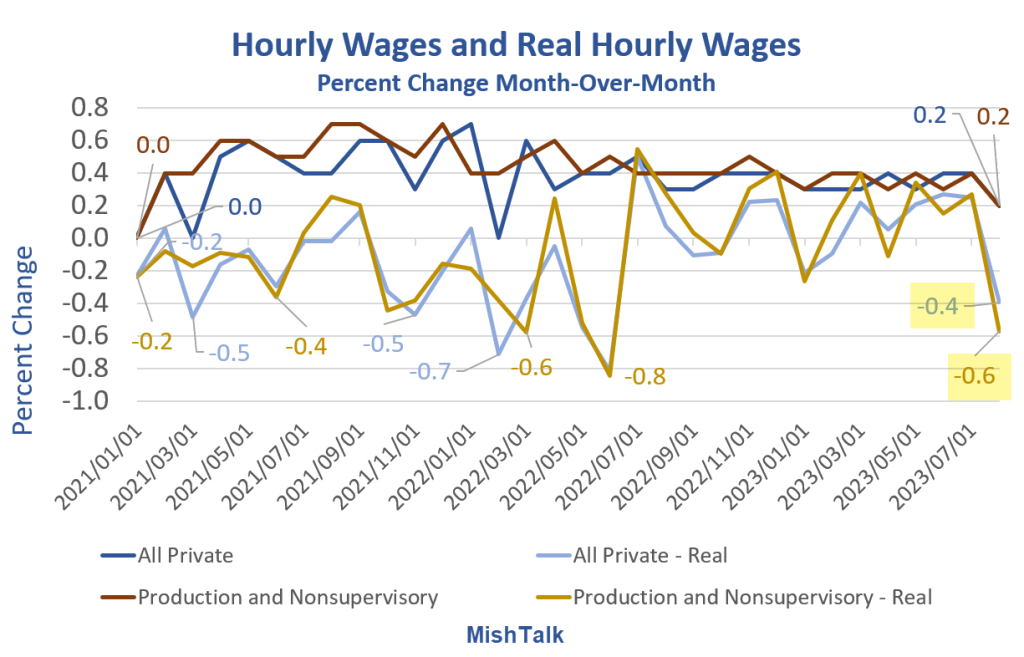Inflation rose in August. This means that real wages (adjusted for inflation) fell. Production and non-supervisory workers were the most affected.
Please note the BLS Real Earnings Report for August 2023.
All employees
- Average real hourly earnings for all employees decreased 0.5 percent from July to August. This result comes from a 0.2 percent increase in average hourly earnings combined with a 0.6 percent increase in the consumer price index for all urban consumers (CPI-U).
- Real average weekly earnings declined 0.1 percent for the month due to the change in real average hourly earnings combined with a 0.3 percent increase in the average work week.
- Actual Hourly July Earnings $11.09
- Actual hourly earnings for August $11.04
Production workers and non-supervisors
- Average real hourly earnings for production and non-supervisory employees decreased a seasonally adjusted 0.6 percent from July to August. This result comes from a 0.2 percent increase in average hourly earnings combined with a 0.8 percent increase in the Consumer Price Index for Urban Wage and Work Workers (CPI-W) .
- Real average weekly earnings declined 0.3 percent for the month as the change in real average hourly earnings was combined with a 0.3 percent increase in the average work week.
- Actual Hourly July Earnings $9.70
- Actual hourly earnings for August $9.64
Geek notes
Rounded to the nearest cent, I calculate the same actual hourly earnings as the BLS. However, I do not calculate the same month-to-month percentage change for all employees as the BLS does. This is the result of intermediate results rounded by the BLS.
The actual hourly wages for July and August to 6 decimal places are $11.085994 and $11.042580 respectively, both of which we round to $11.09 and $11.05.
Using the unrounded numbers, I calculate a change of -0.391606301 which I round to -0.4. Using $11.09 and $11.05 as a starting point, the percentage change is -0.450856628 which the BLS rounds to -0.5.
I think -0.4 percent is more accurate. Regardless, multiple rounding of intermediate numbers instead of rounding the final result is the cause of this discrepancy between my calculations and the BLS.
Breakdown of hourly earnings and actual hourly earnings

Why the feeling is weak
Economic writers continue to wonder why sentiment is weak. Someone on Twitter asked me this just today. The chart above tells you everything you need to know.
Wages seem to have skyrocketed. But adjusted for inflation, wages fall rapidly.
For private workers, since January 2021 wages have risen in nominal terms from $29.92 to $33.82, a seemingly nice gain of $3.90 or 13.0 percent.
Adjusted for inflation, wages for private workers have decreased from $11.39 to $11.04. This represents a decrease of 3.1%. These calculations assume you believe the CPI numbers. Anyone trying to buy a home will scoff at these numbers. So will renters and anyone who doesn’t own their own home.
The long-term numbers have been terrible for years, decades actually.
Hourly Earnings and Real Hourly Earnings

Congratulations to the production workers and non-supervisors! You now earn 26 cents more per hour in real terms than you did in February 1973. That’s about half a cent more every year for 50 years. Well, at least it’s positive. Recent experience is not.
Consumer price inflation increased by 0.6 percent led by energy and housing

I noticed it earlier today Consumer price inflation increased by 0.6 percent led by energy and housing
Gas prices rose 10.6 percent, rent another 0.5 percent, housing 0.3 percent, and new cars 0.3 percent, leading the way to a 0.6 percent CPI increase in August.
Primary residence rent has increased at least 0.4 percent for 25 consecutive months!
Apart from the above (and everything else), Bidenomics works well.
There are many thanks to go around, including Biden and Trump for tariffs and sanctions, Congress, Senator Joe Manchin for saving the ridiculous Inflation Reduction Act that increased inflation, of course the Fed and back to Biden for regulations absurd on several fronts.

